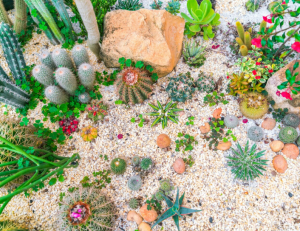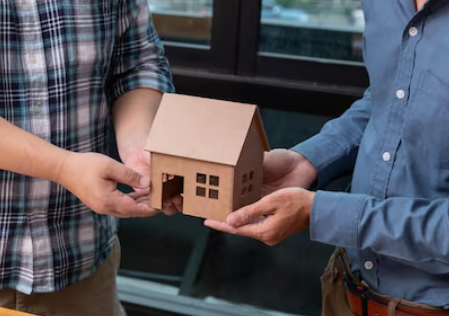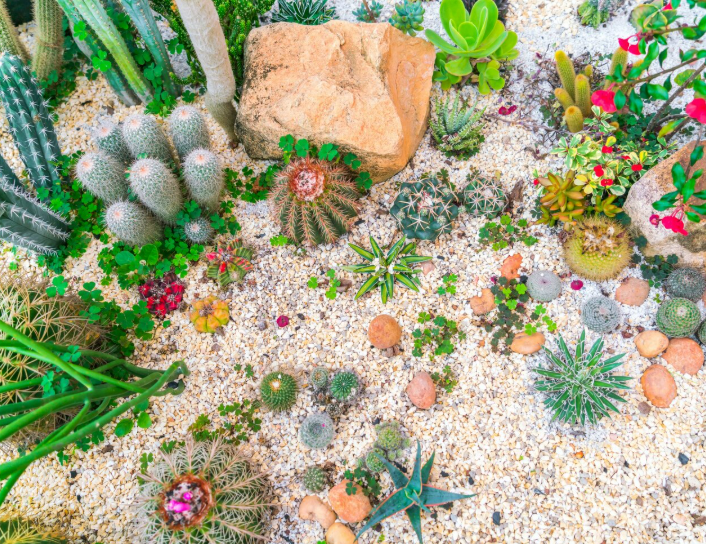How Desert Landscaping Impacts Curb Appeal And Appraised Value In Gilbert?
 In the sunny, fast-growing town of Gilbert, Arizona, landscaping plays a vital role in how a home is perceived and valued. Unlike regions with year-round rainfall and lush greenery, the Sonoran Desert climate requires a different approach—one that emphasizes sustainability, aesthetics, and durability. That’s where desert landscaping—often referred to as xeriscaping—comes into play. According to an elite real estate appraiser, this style of landscaping is not only environmentally responsible but also a proven way to enhance curb appeal and positively influence a property’s appraised value.
In the sunny, fast-growing town of Gilbert, Arizona, landscaping plays a vital role in how a home is perceived and valued. Unlike regions with year-round rainfall and lush greenery, the Sonoran Desert climate requires a different approach—one that emphasizes sustainability, aesthetics, and durability. That’s where desert landscaping—often referred to as xeriscaping—comes into play. According to an elite real estate appraiser, this style of landscaping is not only environmentally responsible but also a proven way to enhance curb appeal and positively influence a property’s appraised value.
With scorching summers, mild winters, and limited annual rainfall, Gilbert residents face unique challenges in maintaining outdoor spaces. Traditional grass lawns demand heavy watering and intensive upkeep—costly and impractical in the desert. Desert landscaping offers a creative and practical solution, using drought-tolerant plants, native species, and efficient hardscapes to produce yards that are both beautiful and water-conscious.
Buyers and appraisers alike notice these thoughtful designs. Well-maintained and aesthetically pleasing landscaping often makes the difference between an “average” property and one that commands top dollar. An attractive yard increases the emotional pull when a buyer first drives up (curb appeal), while features tailored to the environment signal long-term value and sustainability—two qualities appraisers take into account.
The Basics of Desert Landscaping in Gilbert
Desert landscaping—often interchangeably called xeriscaping—is a method of designing outdoor spaces to thrive in low-water environments, particularly in arid regions like Gilbert. The term “xeriscape” comes from the Greek word “xeros,” meaning “dry,” paired with “landscape.” This approach emphasizes climate-appropriate plants, efficient water use, and design aesthetics that reflect the natural beauty of the surrounding environment.
At its core, desert landscaping incorporates:
-
Drought-tolerant plants such as agave, yucca, desert marigold, and red yucca, which thrive on minimal water yet still produce vibrant blooms or architectural foliage.
-
Native trees and shrubs like Palo Verde, desert willow, and mesquite that provide shade, wildlife habitat, and seasonal visual interest.
-
Hardscape materials—gravel, decomposed granite, river rock, and boulders—that reduce the need for irrigation, prevent erosion, and add texture.
-
Irrigation efficiency through drip systems, moisture sensors, and zoning to ensure plants get just the right amount of water.
-
Design harmony that blends the home’s architecture with colors, forms, and textures echoing the surrounding desert.
One of the most compelling aspects of Gilbert desert landscaping is how well it integrates with the local landscape and lifestyle. Neighborhoods featuring low-water designs tend to exude a sense of cohesion and pride because every property reflects the shared value of conserving resources while still presenting a welcoming, attractive front yard.
Another benefit: minimal maintenance. Homeowners can spend less time mowing, edging, and fertilizing while still enjoying a beautiful and seasonal display. For those who travel during peak summer months, a drought-adapted garden greatly reduces the risk of returning home to a dead lawn.
From the perspective of an appraiser, these are lasting improvements. A professionally designed desert landscape signals durability, low ongoing costs, and climate-appropriate planning—all attributes that increase a home’s marketability and can contribute to a stronger appraised value.
Xeriscaping: Sustainability Meets Aesthetics
Xeriscaping lies at the heart of desert landscaping in Gilbert. Far from monotone rock gardens or cactus-only yards, modern xeriscaping blends sustainability with evocative beauty. Its guiding philosophy is to maximize visual appeal using native and drought-tolerant species while minimizing water waste and upkeep. In addition to environmental benefits, xeriscaping can positively influence real estate appraisals, as professionally designed low-maintenance landscapes are increasingly valued by buyers looking for cost savings and curb appeal.
The average Gilbert household can decrease outdoor water usage by 50% or more simply by converting from traditional grass lawns to professionally designed xeriscapes. This isn’t just a cost-saving measure; it’s a solution for combating ongoing drought and supporting the city’s green initiatives. Water scarcity is a persistent concern in the Sonoran Desert, so every savings counts, both for individual bills and for community conservation, while also potentially boosting a home’s appraised value in the competitive Gilbert housing market.
But sustainability doesn’t mean sacrificing style. Contemporary xeriscapes weave together a rich tapestry of colors, textures, and heights. Flowering plants like globe mallow, penstemon, or desert ruellia splash bright reds, oranges, and purples against neutral gravels or boulders. Architectural succulents and cacti add intriguing silhouettes. Layered hardscapes—meandering walkways, artistic stone arrangements—offer an inviting sense of order and creativity. Fringe with delicate desert grasses or low-growing groundcovers softens the effect, making spaces feel lush despite the dryness.
By prioritizing native species, homeowners create resilient landscapes that thrive with minimal supervision. These plants resist pests and diseases, need little fertilization, and withstand temperature extremes common in Gilbert. As a result, yards retain year-round interest—spring and fall bring dramatic blooms, while even winter features sculptural foliage and textural contrasts.
For buyers, the appeal is clear: a well-designed xeriscape sets a tone of elegance and environmental responsibility. Appraisers in Gilbert consistently report that properties with lush, healthy gardens tailored to local conditions garner higher curb appeal scores, influencing both comparative market analysis and appraised value.
Municipal programs sweeten the deal. The Town of Gilbert provides helpful resources, rebates for turf conversion, and educational workshops that guide residents through best practices for selection, irrigation, and maintenance.
Xeriscaping, then, is not just a landscaping method—it’s a lifestyle choice that aligns with the community’s environmental goals and homeowner priorities. Its popularity continues to grow as new neighborhoods and remodels favor it for its beauty, practicality, and value.
Enhancing Curb Appeal: The First Impression
Curb appeal is that essential, immediate impression a home makes when others first see it from the street. In competitive real estate markets like Gilbert, it can make or break a sale, influencing everything from prospective buyers’ interest to appraisers’ scoring. Desert landscaping directly elevates this first impression by using innovative design, vivid plantings, and strategic hardscapes.
Gone are the days when a patch of thirsty grass or a scattering of rocks constituted “desert style.” Today’s curb appeal rests on deliberate composition, cohesion, and a masterful blend of elements:
- Bold focal points: Giant blue agave or flowering ocotillo command attention, greeting guests with a unique sense of place. Boulders, decorative pots, or sculptural metalwork add visual drama right at the entrance.
- Defined walkways and entry zones: Gravel or stone pathways create a sense of guidance and elegance. Plant borders—often made from Texas sage, lantana, or desert spoon—provide structure while showcasing seasonal color.
- Vivid accents: Even arid gardens can offer dazzling displays—think desert marigolds, penstemons, or firecracker bush clustered near the front for maximum visual punch during blooming seasons.
- Lighting features: Solar-powered uplights or strategically placed LED fixtures highlight architectural and plant features, extending curb appeal into the evening hours while enhancing security.
- Layered textures: Combining fine gravels, large flagstones, wispy grasses, and clustered shrubs creates visual rhythm and depth, echoing the complexity of the desert itself.
Curb appeal isn’t just aesthetic; it reflects care and pride. Well-designed landscape beds that are weed-free and neatly mulched convey professionalism and attention to detail. This boosts buyers’ confidence in the overall maintenance of the home—and increases perceived value.
Appraisers take note of these visible improvements. A front yard that “pops” tells them a property has been thoughtfully enhanced to suit its environment, which can merit a positive adjustment in the appraisal. Neighborhoods where multiple homes feature smart, cohesive desert landscaping set a higher baseline, driving values collectively upward.
Of course, desert landscaping also ensures year-round curb appeal. Unlike seasonal or temperamental lawns that brown in heat or frost, xeriscaped yards maintain interest and vibrancy every month of the year, making properties look inviting to prospective buyers and guests alike.
In Gilbert, embracing desert plantings and native design helps your home stand out—creating that critical “wow factor” at first glance.
Increasing Appraised Property Value
The connection between landscaping and appraised property value is well established. In Gilbert, desert landscaping consistently adds measurable financial benefit, both directly and indirectly, to homes willing to invest in sustainable, climate-adapted design.
National studies routinely show that attractive landscaping can add 5% to 15% to property value. In the context of Gilbert’s median home prices, this can represent tens of thousands of dollars. However, desert landscaping provides extra value because it signals low ongoing costs, environmental savvy, and resilience—a winning formula for buyers and appraisers alike.
When appraisers assess a property, they use a combination of comparative market analysis, visible improvements, and regionally appropriate standards. Features evaluated include:
- Design sophistication: Cohesive, professionally planned landscapes garner higher appraised values. Plans with intentional plant selection, grading, and aesthetically pleasing groupings are superior to basic or haphazard efforts.
- Plant maturity and health: Mature trees and shrubs offer shade, privacy, and instant beauty. Healthy, established plants contribute more value than young or neglected ones.
- Functional hardscapes: Walkways, patios, and seating areas expand usable square footage, making the yard more livable and boosting the home’s appraised worth.
- Maintenance level: A tidy, thriving yard increases appraised value, while signs of neglect—such as dead patches, overgrown plants, or deferred maintenance—can detract and trigger deductions.
In Gilbert, desert landscaping has proven market appeal. Many buyers actively seek xeriscaped properties because they understand the long-term savings, reduced hassle, and contemporary aesthetics. This demand incentivizes sellers to invest in landscape upgrades both before listing and during appraisals.
Appraisers also weigh sustainability. Native plantings, water-efficient irrigation systems, and reduced chemical use position properties as low-risk, low-cost investments. Modern buyers, especially millennials and environmentally conscious families, are increasingly aware of ongoing utility and maintenance expenses, making desert landscaping even more attractive.
The Role of Shade Trees in Energy Efficiency and Comfort
Shade trees are powerful assets in Gilbert’s desert yards, providing both immediate comfort and long-term financial savings. Their capacity to cool homes, patios, and outdoor spaces translates into increased livability—and, crucially, higher property values.
Cooling benefits are dramatic. Trees like Mesquite, Ironwood, or Desert Willow block sunlight, reduce radiant heat, and help maintain pleasant temperatures inside homes. Proper placement—particularly on southern, western, or eastern exposures—can reduce energy use for air conditioning by up to 25% in the summer.
Beyond energy savings, shade trees create inviting outdoor living areas. Shaded patios, lawns, or walkways allow families to enjoy their yards mornings and evenings, increasing usable space and elevating quality of life in Gilbert’s hot climate.
Appraised value jumps with mature trees. National studies suggest that homes with mature shade trees in the right boroughs command 7%–19% higher appraised values than those without. In the desert, where cooling costs are high, the premium is even greater.
Shade trees also support the local ecosystem, offering habitat and food for birds and pollinators. Their deep roots stabilize soil, help manage rainwater runoff, and prevent erosion—a key consideration in monsoon season.
When planning your landscape, consider:
- Tree selection: Stick to locally adapted species—Palo Verde, Desert Willow, Arizona Ash, and Mesquite are reliable.
- Placement: Locate trees to optimize shading for windows, rooflines, and outdoor living zones.
- Maintenance: Prune and water properly, especially during establishment years, to ensure healthy growth and longevity.
- Long-term planning: Mature trees take years to reach full size, but interim benefits begin quickly, enhancing both comfort and market value.
Appraisers, buyers, and local governments recognize the powerful impact shade trees have—rewarding investments in tree planting with greater property worth and community appeal.
Hardscape Features: Stones, Pathways, and Outdoor Living Spaces
Hardscaping transforms desert yards from simple gardens into full outdoor living environments, increasing both property value and daily enjoyment. In Gilbert, where the climate favors year-round outdoor activities, features like patios, walkways, fire pits, and outdoor kitchens are especially desirable.
Rock gardens and boulders provide visual anchors and texture. Carefully placed stones frame plant beds, create terraces, and define transitions between functional areas—such as a gravel walk winding through flowering shrubs.
Custom pavers and flagstone pathways guide visitors, enhance curb appeal, and support accessibility. Well-designed walkways connect entrances, patios, and side yards, making gardens more usable for families and guests.
Outdoor living spaces—kitchens, fire pits, shaded seating zones—expand the home’s square footage beyond its walls. These amenities are highly valued in Gilbert’s market, where entertaining outdoors is a year-round experience. Retaining walls and built-in benches add architectural interest and support social gatherings.
Water features—such as recirculating fountains or small ponds—enhance tranquility and attract wildlife, while remaining sustainable when designed for arid climates.
From an appraiser’s perspective, hardscape brings tangible benefits:
- It requires little maintenance and remains attractive regardless of weather cycles.
- Professional installation adds value equivalent to a renovated room indoors.
- Permanent features signal durability and high construction standards.
- Functional hardscapes—such as seating or outdoor kitchens—are valued especially highly by families and buyers seeking lifestyle upgrades.
To maximize return, combine plantings and hardscape for a balanced look. Excessive stone can cause heat build-up, so incorporate shade and greenery for cooling and comfort.
Gilbert’s landscape designers excel at creating customized, locally appropriate solutions—blending artful stonework with lush, drought-resistant gardens. The result: yards that blur the line between indoor luxury and outdoor sanctuary.
Common Pitfalls and How to Maximize Desert Landscape Value
Desert landscaping offers transformative benefits, but only if executed properly. Mistakes can reduce curb appeal, discourage buyers, and ultimately detract from appraised value. Knowing what to avoid—and how to optimize design and maintenance—is key for Gilbert homeowners.
Common pitfalls include:
- Sparse or uneven planting: Large areas of bare rock without sufficient greenery create a barren look and repel buyers. Balance hardscape with layered, colorful plantings for a natural, cohesive feel.
- Poor plant selection: Non-native species often underperform, requiring extra water and care. Sticking to local favorites reduces headaches and delivers better results.
- Neglect and over-pruning: Stressed plants from infrequent watering or aggressive trimming become weak and unsightly. Regular, gentle maintenance is crucial.
- Excess hardscape: While rocks and boulders are attractive, too much can increase the heat island effect and clash with neighborhood styles.
- Ignoring local guidelines: Overuse of turf, inefficient irrigation, or unsightly additions can violate HOA rules or attract negative scrutiny.
Maximizing value and appeal:
- Invest in design or professional advice. Local experts know which plants, layouts, and features work best for the region.
- Prioritize native plants and efficient watering. Drip irrigation and soil amendments keep plants healthy with minimal effort.
- Focus on regular maintenance. Weed, prune, and refresh gravel or mulch seasonally to maintain a tidy appearance.
- Personalize with art, lighting, and inviting pathways. Artistic touches add character and help properties stand out.
- Plan for the long term. Consider maturation and future upkeep; what looks good today should improve with age.
Appraisers reward property owners who demonstrate thoughtful management and pride. Buyers respond emotionally to beautiful, functional landscapes. By learning from others’ mistakes—and choosing proven strategies—homeowners amplify both enjoyment and return on investment.
Conclusion
Desert landscaping is reshaping neighborhoods across Gilbert, bringing together beauty, sustainability, and economic value. By choosing native plants, creative hardscaping, and climate-smart irrigation, homeowners create vibrant yards that endure the region’s challenges and celebrate its character.
Curb appeal surges, market values jump, and environmental stewardship gains notice. Whether you’re sprucing up a starter home, planning to sell, or simply striving for a more enjoyable outdoor space, the principles of desert landscaping deliver lasting returns—financially, emotionally, and ecologically.
Eagle Home Appraisal Gilbert encourages property owners to embrace these insights. With thoughtful design, regular care, and strategic investments, your landscape will not only beautify your home but also help drive the future of Gilbert’s residential market. If you’re ready to boost your property’s curb appeal and value, contact our team for expert guidance and appraisal services tailored to your distinctive vision.
Next Up: Does proximity to parks or schools raise appraisal values in Gilbert neighborhoods? In our next post, we’ll explore the connection between neighborhood amenities and home value, and why expert guidance is often essential when assessing the true worth of a property.
Divorce Appraisals
At Eagle Home Appraisal Gilbert, we specialize in providing expert divorce appraiser services, offering expert witness testimony when necessary.
Estate & Trust Appraisals
At Eagle Home Appraisal Gilbert, we offer a comprehensive range of professional estate appraisal services to facilitate estate and trust planning.
IRS & Tax Appraisals
At Eagle Home Appraisal Gilbert, we specialize in providing professional IRS tax appraisal services to minimize capital gains on inherited property.
Real Estate Appraisal
Eagle Home Appraisal is a group of independent fee appraisers committed to delivering competent, credible, and reliable appraisal reports.
Eagle Home Appraisal Services Near Me
Comprehensive Property Appraisals
Expert Witness Testimony
Fair Market Value Assessments
Rapid Turnaround Times
Customized Solutions
Contact Eagle Home Appraisal Today
For more information about our services, get in touch with Eagle Home Appraisal. Our team is dedicated to providing the best customer service, ensuring all your appraisal needs are met with professionalism and expertise. Contact us today to learn more about how we can assist you.
Get A Free Consultation

copyright @2025 all rights reserved | Privacy-policy





